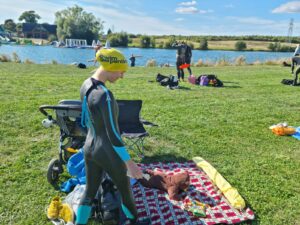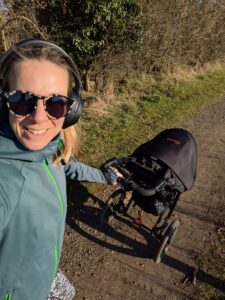I had never heard of PGP before when I got pregnant. I was fairly active, running a couple of times a week, cycling to work every day, open water swimming once a week and indoor bouldering once a week. I had done a few triathlons and running and cycling events. I trimmed this right down in early pregnancy because I was so nauseous and exhausted. This improved but I began to feel pain on the left side of my pubic bone when walking at around 20 weeks.
I mentioned the pain to my midwife, and she dismissed it saying it was normal; to keep active and it would go after the baby was born. I later spoke to a consultant following a referral for constant migraines. When I mentioned this pubic bone pain she referred me for physiotherapy. All along I was told to keep active, keep walking. We were moving house around then and changing hospitals, but I was given an appointment for an online class which I kept but it wasn’t for a few months’ time. Over the next month I went downhill rapidly. I remember trying to go for a walk and telling my partner and a friend that I needed to walk slowly. They didn’t quite get how slowly I meant. I turned back after a short distance. It took me half an hour to do a 10 minute walk back and when I got home, I couldn’t get through the door. I couldn’t lift my foot to go through the doorway and just cried.
My partner found me a private physio and I booked an appointment but there was a wait for availability until the day after my NHS online appointment. In the meantime, I had found the Pelvic Partnership website through searching my symptoms online and identified that this was pelvic girdle pain (PGP) and that there were things I could avoid doing to help and that I should seek manual therapy treatment. The NHS online appointment was a Teams call where we were provided with information and exercises. They said that PGP was frequently due to a lack of exercise and high BMI. I, like others who have been told this, found this suggestion dismissive and insulting. The individual had not met anyone in the call or asked about their history. They had not seen us in person or done any kind of physical assessment. It felt they were implying that it was likely our fault. When I became pregnant, I had never been fitter in my life. We were sent information sheets about PGP and with exercises to do. This information largely stated that PGP is caused by increased ligament flexibility due to elevated Relaxin levels during pregnancy, increased weight during pregnancy and postural changes. I physically couldn’t do most of the exercises and trying caused me pain. A follow up email said that I could request further assessment from a physiotherapist, but by this point I had moved house and transferred to a different hospital.
When I saw the private physio in person, she actually listened to me. She explained PGP and she looked at me, assessed my joints and found that my joints were not moving symmetrically. She realigned my pelvis and I left feeling better. By this point things had got so severe I was only able to maintain my mobility at the level I was
I had a traumatic birth with days of labour, failed forceps with only a local anaesthetic injection and an unplanned caesarean. When forceps were suggested I declined and requested a caesarean as I hadn’t wanted interventions that would necessitate a lithotomy position. I was told it was the best option and pressured until I consented. The consultant wouldn’t listen to myself and my partner telling her not to force my leg to move, she said it wouldn’t do any damage and would be fine. I walked slowly with a limp for the next two years and had problems with symphysis pubis pain,
I got pregnant again when my daughter was around 14 months. I hadn’t stopped seeing my private physio and we switched the approach back to management rather than trying to build back strength. I cut back anything too strenuous and was careful enough that I could walk for the whole pregnancy without crutches. This was a great improvement on my previous pregnancy.
My son was born unexpectedly at 32+5 weeks. I had been referred to the pre-term birth clinic earlier on in pregnancy, due to undergoing a caesarean when fully dilated previously, but was discharged from this clinic around 24 weeks. I had planned a caesarean birth at a different hospital due to the previous trauma. Unfortunately, as I went into labour early, arriving to hospital at 10cm during a doctor’s strike, there was no doctor available to do the caesarean. After a long wait I was able to have an epidural and give birth to my son vaginally, which I was glad of in the end. I had never wanted a caesarean for either birth, but by the second I planned one as I was too afraid after my previous experience. After my son was born my PGP had reduced significantly. I was unwell and stayed in hospital for four days but when I left he stayed in the neonatal unit for three weeks so straight away I was travelling to and from the hospital and looking after my daughter who was not yet two. There is no way I could have done this without such a huge reduction in pain. My physio said that the birth had released some tension in my pelvic floor and helped my symptoms.
Gradually I was able to do more and start to exercise. I began gentle postnatal mum and baby exercise classes two months post-partum which
I hope with more time, as my children get older and I have more time to build strength, that I will see less of these flare ups and my body will be resilient enough to support itself. I wish my PGP had been understood and explained to me when I first experienced pain, and that I had been listened to during the birth of my children. If I had been listened to and understood during pregnancy and labour, and given relevant information and support, I am certain that I would have been able to remain mobile during both pregnancies and would have made a faster recovery both times. Experiencing PGP has been life changing for me and impacted every element of my life. I was totally unprepared for it and felt I was left to find support alone. I was so glad to find the Pelvic Partnership, who understood my experience and gave me confidence that recovery was possible.